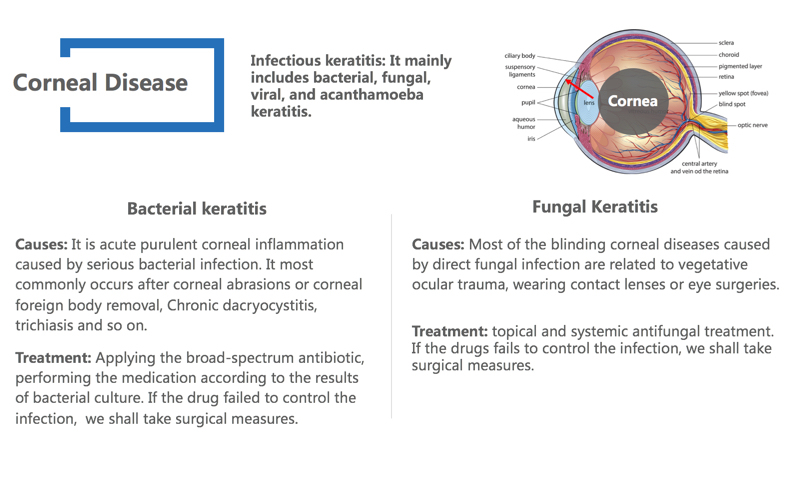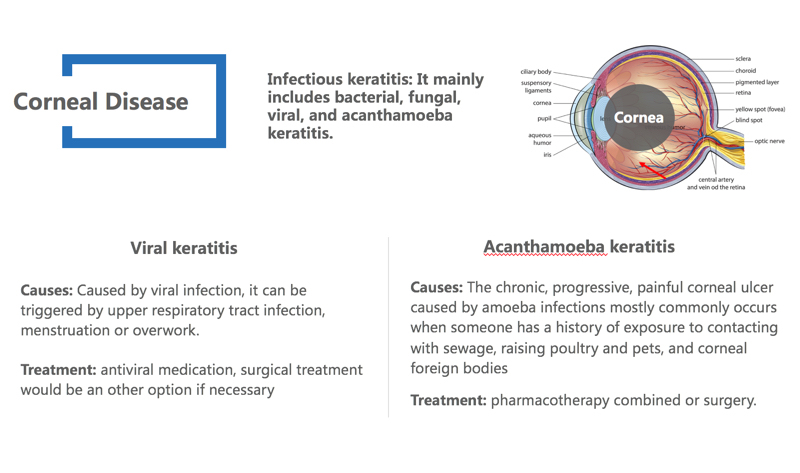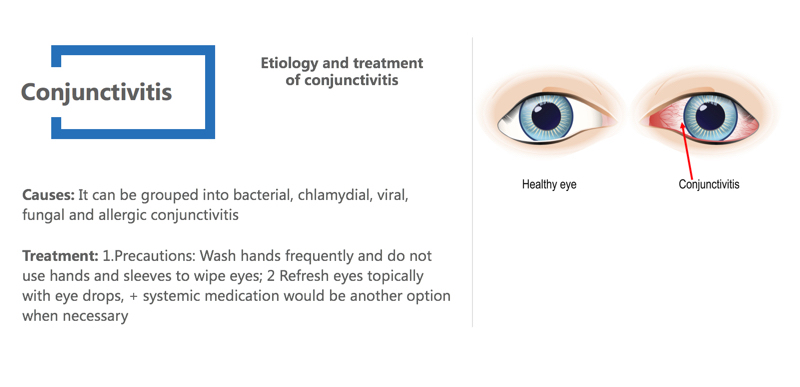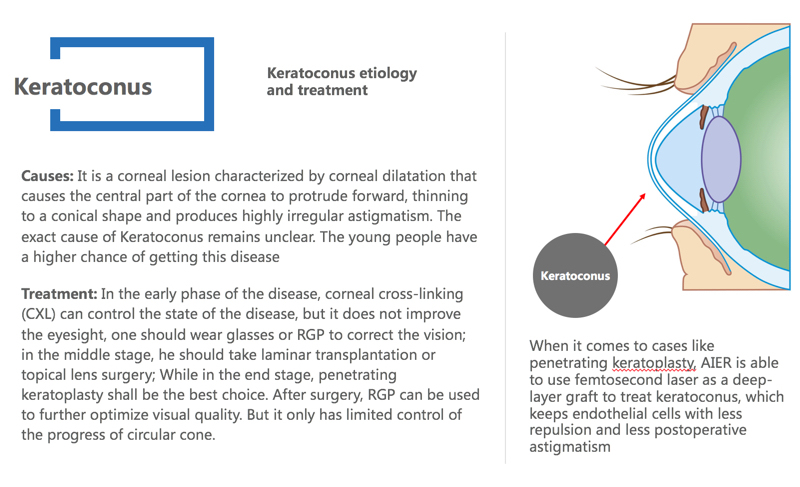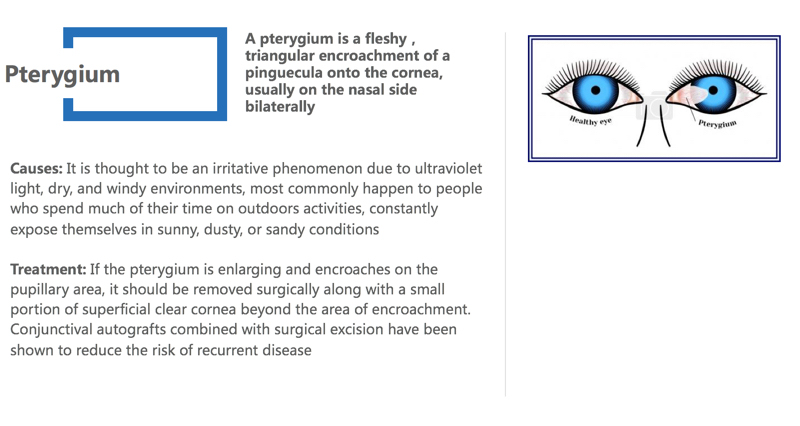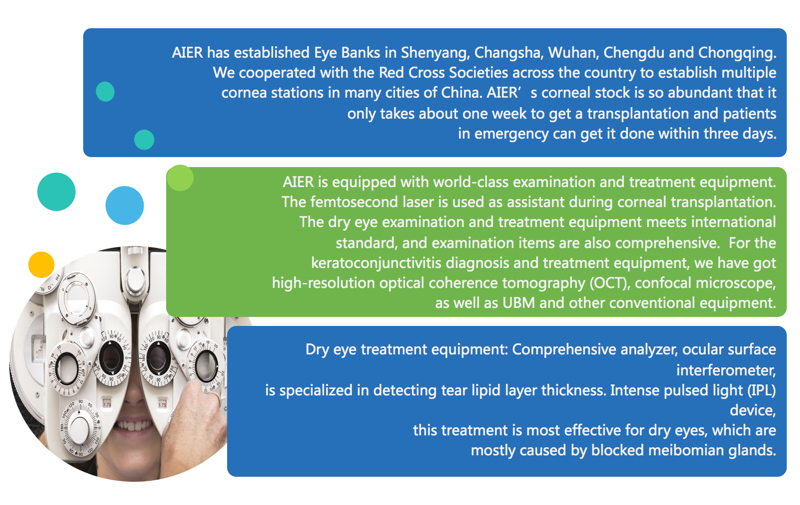Corneal Diseases
2022-11-24 17:20:13
Bacterial keratitis Causes: It is acute purulent corneal inflammation caused by serious bacterial infection. It most commonly occurs after corneal abrasions or corneal foreign body removal, Chronic dacryocystitis, trichiasis and so on.Treatment: Applying the broad-spectrum antibiotic, performing the medication according to the results of bacterial culture. If the drug failed to control the infection, we shall take surgical measures. Fungal Keratitis Causes: Most of the blinding corneal diseases caused by direct fungal infection are related to vegetative ocular trauma, wearing contact lenses or eye surgeries. Treatment: topical and systemic antifungal treatment. If the drugs fails to control the infection, we shall take surgical measures.
Viral keratitis Causes: Caused by viral infection, it can be triggered by upper respiratory tract infection, menstruation or overwork.Treatment: antiviral medication, surgical treatment would be an other option if necessary Acanthamoeba keratitis Causes: The chronic, progressive, painful corneal ulcer caused by amoeba infections mostly commonly occurs when someone has a history of exposure to contacting with sewage, raising poultry and pets, and corneal foreign bodies Treatment: pharmacotherapy combined or surgery.
Causes: It can be grouped into bacterial, chlamydial, viral, fungal and allergic conjunctivitis Treatment: 1.Precautions: Wash hands frequently and do not use hands and sleeves to wipe eyes; 2 Refresh eyes topically with eye drops, + systemic medication would be another option when necessary
Causes: There are multiple reasons which may lead to the abnormal quality or quantity of the ocular surface, such as lack of fluid, mucin, lipid and abnormal tear dynamics Treatment: symptomatic treatment. Such as the applying of artificial tears, hot compresses on meibomian gland, IPL and lacrimal plug.
Causes: It is a corneal lesion characterized by corneal dilatation that causes the central part of the cornea to protrude forward, thinning to a conical shape and produces highly irregular astigmatism. The exact cause of Keratoconus remains unclear. The young people have a higher chance of getting this disease Treatment: In the early phase of the disease, corneal cross-linking (CXL) can control the state of the disease, but it does not improve the eyesight, one should wear glasses or RGP to correct the vision; in the middle stage, he should take laminar transplantation or topical lens surgery; While in the end stage, penetrating keratoplasty shall be the best choice. After surgery, RGP can be used to further optimize visual quality. But it only has limited control of the progress of circular cone. When it comes to cases like penetrating keratoplasty, AIER is able to use femtosecond laser as a deep-layer graft to treat keratoconus, which keeps endothelial cells with less repulsion and less postoperative astigmatism
Causes: It is thought to be an irritative phenomenon due to ultraviolet light, dry, and windy environments, most commonly happen to people who spend much of their time on outdoors activities, constantly expose themselves in sunny, dusty, or sandy conditions Treatment: If the pterygium is enlarging and encroaches on the pupillary area, it should be removed surgically along with a small portion of superficial clear cornea beyond the area of encroachment. Conjunctival autografts combined with surgical excision have been shown to reduce the risk of recurrent disease
There are more than 70 cornea and ocular surface specialists in AIER's corneal department. The experts team consists of members of the Ophthalmology Branch of the Chinese Medical Association and professors of AIER School of Ophthalmology of Central South University. The numbers of corneal department's annual outpatient and operation ranks the forward position in China.
AIER is one of the earliest ophthalmology institutions in China that carried out corneal transplantation and pterygium surgery. In AIER, all kinds of corneal surgeries can be effectively operated. AIER was the first in China to carry out femtosecond laser corneal transplantation, corneal endothelial transplantation without tearing the elastic layer, and using femtosecond laser to perform endothelial transplantation to treat graft turbidity after penetrating keratoplasty. Meanwhile, AIER is medical institution in China in terms of pterygium high surgery volume.
AIER has established Eye Banks in Shenyang, Changsha, Wuhan, Chengdu and Chongqing.
We cooperated with the Red Cross Societies across the country to establish multiple
cornea stations in many cities of China. AIER’s corneal stock is so abundant that it
only takes about one week to get a transplantation and patients
in emergency can get it done within three days. AIER is equipped with world-class examination and treatment equipment.
The femtosecond laser is used as assistant during corneal transplantation.
The dry eye examination and treatment equipment meets international
standard, and examination items are also comprehensive. For the
keratoconjunctivitis diagnosis and treatment equipment, we have got
high-resolution optical coherence tomography (OCT), confocal microscope,
as well as UBM and other conventional equipment.Dry eye treatment equipment: Comprehensive analyzer, ocular surface interferometer,
is specialized in detecting tear lipid layer thickness. Intense pulsed light (IPL) device,
this treatment is most effective for dry eyes, which are
mostly caused by blocked meibomian glands.
